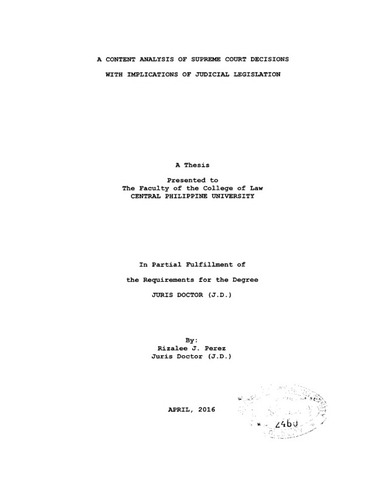A content analysis of Supreme Court decisions with implications of judicial legislation
요약
ʺBalikan ninyo ang mabibigat at kontrobersiyal na isyung kinaharap ng hudikatura, gaya ng mga panahong nagging kataka-taka ang posisyon ng isa o iilang mahistrado, kung kalian biglang nagbago ang pananaw ng korte sa mahahalagang usapin, o tila nagkaroon ng judicial legislation (Look back at the controversial issues faced by the judiciary, like situations when the position of one or a few justices were puzzling, when the court's decision about an important issue suddenly changed or there is so-called judicial legislation),ʺ ---President Benigno Aquino III
The Philippine Government is divided into three branches namely, the Executive, the Legislative and the Judiciary. The Legislative department enacts the laws, the Judiciary interprets them and the Executive is charged with the enforcement of such laws. Pursuant to the Doctrine of Separation of Powers, each branch is precluded from interfering with the functions of the other branches. However, the Judiciary seemed to have encroached upon the functions of the Legislature by committing judicial legislation.
The purpose of this study was to determine the cases decided by the Supreme Court with implications of judicial legislation. Specifically, it aimed to determine the type of cases where the Supreme Court committed judicial legislation, the frequency the High Court commits such and the reasons that induced it to commit a violation of the doctrine of separation of powers.
Using information provided in Supreme Court decisions, Legislative Journal, official publications, on-line resources and numerous articles, the data gathered were analysed in order to assess the probable impact and legal implications of judicial legislation in order to make a recommendation that would help in avoiding the commission of such violation of separation of powers.
The researcher used the content analysis and studied the cases decided by the Supreme Court from 2005-2015 which were said to have implications of judicial legislation. Of the nine (9) cases with implications of judicial legislation, five (5) were administrative cases, three (3) were civil cases and only one (1) was a criminal case. The Supreme Court was careful enough not to commit judicial legislation in their rulings as evidenced by the fact that only one or two cases every year from 2005 to 2015 were with implications of judicial legislation. The main reason behind the commission of the High Court of judicial legislation is that it wanted to give the law a construction that reflects the intent of its framers.
The Justices of the Supreme Court may have the best intentions in deciding cases filed before them and in construing the applicable laws in such cases. However, if something is missing in the law, the Judiciary is without power to supply the said missing piece because such is the duty of the Legislative department. The Supreme Court acts with grave abuse of its power in amending a legislative act in the guise of construction.
기술
Abstract only
추천 인용
Perez, R. J. (2016). A content analysis of Supreme Court decisions with implications of judicial legislation (Unpublished postgraduate thesis). Central Philippine University, Jaro, Iloilo City.
유형
Thesis주제
키워드
학과
College of Law정도
Juris Doctor선반 위치
Law Library 340.72 P415
물리적 설명
ix, 64 leaves
Collections
- Juris Doctor [144]
다음 라이센스 파일이이 항목과 연관되어 있습니다.



